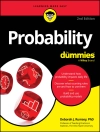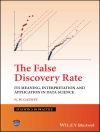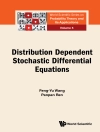Meta Analysis: A Guide to Calibrating and Combining Statistical Evidence acts as a source of basic methods for scientists wanting to combine evidence from different experiments. The authors aim to promote a deeper understanding of the notion of statistical evidence.
The book is comprised of two parts –
The Handbook, and
The Theory.
The Handbook is a guide for combining and interpreting experimental evidence to solve standard statistical problems. This section allows someone with a rudimentary knowledge in general statistics to apply the methods.
The Theory provides the motivation, theory and results of simulation experiments to justify the methodology.
This is a coherent introduction to the statistical concepts required to understand the authors’ thesis that evidence in a test statistic can often be calibrated when transformed to the right scale.
表中的内容
Preface xiii
Part I The Methods 1
1 What can the reader expect from this book? 3
1.1 A calibration scale for evidence 4
1.1.1 T-values and p-values 4
1.1.2 How generally applicable is the calibration scale? 6
1.1.3 Combining evidence 7
1.2 The efficacy of glass ionomer versus resin sealants for prevention of caries 8
1.2.1 The data 8
1.2.2 Analysis for individual studies 9
1.2.3 Combining the evidence: fixed effects model 10
1.2.4 Combining the evidence: random effects model 10
1.3 Measures of effect size for two populations 11
1.4 Summary 13
2 Independent measurements with known precision 15
2.1 Evidence for one-sided alternatives 15
2.2 Evidence for two-sided alternatives 18
2.3 Examples 19
2.3.1 Filling containers 19
2.3.2 Stability of blood samples 20
2.3.3 Blood alcohol testing 20
3 Independent measurements with unknown precision 23
3.1 Effects and standardized effects 23
3.2 Paired comparisons 26
3.3 Examples 27
3.3.1 Daily energy intake compared to a fixed level 27
3.3.2 Darwin’s data on Zea mays 28
4 Comparing treatment to control 31
4.1 Equal unknown precision 31
4.2 Differing unknown precision 33
4.3 Examples 35
4.3.1 Drop in systolic blood pressure 35
4.3.2 Effect of psychotherapy on hospital length of stay 37
5 Comparing K treatments 39
5.1 Methodology 39
5.2 Examples 42
5.2.1 Characteristics of antibiotics 42
5.2.2 Red cell folate levels 43
6 Evaluating risks 47
6.1 Methodology 47
6.2 Examples 49
6.2.1 Ultrasound and left-handedness 49
6.2.2 Treatment of recurrent urinary tract infections 49
7 Comparing risks 51
7.1 Methodology 51
7.2 Examples 54
7.2.1 Treatment of recurrent urinary tract infections 54
7.2.2 Diuretics in pregnancy and risk of pre-eclamsia 54
8 Evaluating Poisson rates 57
8.1 Methodology 57
8.2 Example 60
8.2.1 Deaths by horse-kicks 60
9 Comparing Poisson rates 63
9.1 Methodology 64
9.1.1 Unconditional evidence 64
9.1.2 Conditional evidence 65
9.2 Example 67
9.2.1 Vaccination for the prevention of tuberculosis 67
10 Goodness-of-fit testing 71
10.1 Methodology 71
10.2 Example 74
10.2.1 Bellbirds arriving to feed nestlings 74
11 Evidence for heterogeneity of effects and transformed effects 77
11.1 Methodology 77
11.1.1 Fixed effects 77
11.1.2 Random effects 80
11.2 Examples 81
11.2.1 Deaths by horse-kicks 81
11.2.2 Drop in systolic blood pressure 82
11.2.3 Effect of psychotherapy on hospital length of stay 83
11.2.4 Diuretics in pregnancy and risk of pre-eclamsia 84
12 Combining evidence: fixed standardized effects model 85
12.1 Methodology 86
12.2 Examples 87
12.2.1 Deaths by horse-kicks 87
12.2.2 Drop in systolic blood pressure 88
13 Combining evidence: random standardized effects model 91
13.1 Methodology 91
13.2 Example 94
13.2.1 Diuretics in pregnancy and risk of pre-eclamsia 94
14 Meta-regression 95
14.1 Methodology 95
14.2 Commonly encountered situations 98
14.2.1 Standardized difference of means 98
14.2.2 Difference in risk (two binomial proportions) 99
14.2.3 Log relative risk (two Poisson rates) 99
14.3 Examples 100
14.3.1 Effect of open education on student creativity 100
14.3.2 Vaccination for the prevention of tuberculosis 101
15 Accounting for publication bias 105
15.1 The downside of publishing 105
15.2 Examples 107
15.2.1 Environmental tobacco smoke 107
15.2.2 Depression prevention programs 109
Part II The Theory 111
16 Calibrating evidence in a test 113
16.1 Evidence for one-sided alternatives 114
16.1.1 Desirable properties of one-sided evidence 115
16.1.2 Connection of evidence to p-values 115
16.1.3 Why the p-value is hard to understand 116
16.2 Random p-value behavior 118
16.2.1 Properties of the random p-value distribution 118
16.2.2 Important consequences for interpreting p-values 119
16.3 Publication bias 119
16.4 Comparison with a Bayesian calibration 121
16.5 Summary 123
17 The basics of variance stabilizing transformations 125
17.1 Standardizing the sample mean 125
17.2 Variance stabilizing transformations 126
17.2.1 Background material 126
17.2.2 The Key Inferential Function 127
17.3 Poisson model example 128
17.3.1 Example of counts data 129
17.3.2 A simple vst for the Poisson model 129
17.3.3 A better vst for the Poisson model 132
17.3.4 Achieving a desired expected evidence 132
17.3.5 Confidence intervals 132
17.3.6 Simulation study of coverage probabilities 134
17.4 Two-sided evidence from one-sided evidence 134
17.4.1 A vst based on the chi-squared statistic 135
17.4.2 A vst based on doubling the p-value 137
17.5 Summary 138
18 One-sample binomial tests 139
18.1 Variance stabilizing the risk estimator 139
18.2 Confidence intervals for p 140
18.3 Relative risk and odds ratio 142
18.3.1 One-sample relative risk 143
18.3.2 One-sample odds ratio 144
18.4 Confidence intervals for small risks p 145
18.4.1 Comparing intervals based on the log and arcsine transformations 145
18.4.2 Confidence intervals for small p based on the Poisson approximation to the binomial 146
18.5 Summary 147
19 Two-sample binomial tests 149
19.1 Evidence for a positive effect 149
19.1.1 Variance stabilizing the risk difference 149
19.1.2 Simulation studies 151
19.1.3 Choosing sample sizes to achieve desired expected evidence 151
19.1.4 Implications for the relative risk and odds ratio 153
19.2 Confidence intervals for effect sizes 153
19.3 Estimating the risk difference 155
19.4 Relative risk and odds ratio 155
19.4.1 Two-sample relative risk 155
19.4.2 Two-sample odds ratio 157
19.4.3 New confidence intervals for the RR and OR 157
19.5 Recurrent urinary tract infections 157
19.6 Summary 158
20 Defining evidence in t-statistics 159
20.1 Example 159
20.2 Evidence in the Student t-statistic 159
20.3 The Key Inferential Function for Student’s model 162
20.4 Corrected evidence 164
20.4.1 Matching p-values 164
20.4.2 Accurate confidence intervals 166
20.5 A confidence interval for the standardized effect 167
20.5.1 Simulation study of coverage probabilities 169
20.6 Comparing evidence in t- and z-tests 170
20.6.1 On substituting s for s in large samples 170
20.7 Summary 171
21 Two-sample comparisons 173
21.1 Drop in systolic blood pressure 173
21.2 Defining the standardized effect 174
21.3 Evidence in the Welch statistic 175
21.3.1 The Welch statistic 175
21.3.2 Variance stabilizing the Welch t-statistic 176
21.3.3 Choosing the sample size to obtain evidence 177
21.4 Confidence intervals for d 177
21.4.1 Converting the evidence to confidence intervals 177
21.4.2 Simulation studies 178
21.4.3 Drop in systolic blood pressure (continued) 179
21.5 Summary 179
22 Evidence in the chi-squared statistic 181
22.1 The noncentral chi-squared distribution 181
22.2 A vst for the noncentral chi-squared statistic 182
22.2.1 Deriving the vst 182
22.2.2 The Key Inferential Function 183
22.3 Simulation studies 184
22.3.1 Bias in the evidence function 184
22.3.2 Upper confidence bounds; confidence intervals 185
22.4 Choosing the sample size 188
22.4.1 Sample sizes for obtaining an expected evidence 188
22.4.2 Sample size required to obtain a desired power 190
22.5 Evidence for l > l 0 190
22.6 Summary 191
23 Evidence in F-tests 193
23.1 Variance stabilizing transformations for the noncentral F 193
23.2 The evidence distribution 197
23.3 The Key Inferential Function 200
23.3.1 Refinements 203
23.4 The random effects model 203
23.4.1 Expected evidence in the balanced case 205
23.4.2 Comparing evidence in REM and FEM 206
23.5 Summary 206
24 Evidence in Cochran’s Q for heterogeneity of effects 207
24.1 Cochran’s Q: the fixed effects model 208
24.1.1 Background material 208
24.1.2 Evidence for heterogeneity of fixed effects 210
24.1.3 Evidence for heterogeneity of transformed effects 211
24.2 Simulation studies 211
24.3 Cochran’s Q: the random effects model 214
24.4 Summary 218
25 Combining evidence from K studies 219
25.1 Background and preliminary steps 219
25.2 Fixed standardized effects 220
25.2.1 Fixed, and equal, standardized effects 220
25.2.2 Fixed, but unequal, standardized effects 221
25.2.3 Nuisance parameters 221
25.3 Random transformed effects 222
25.3.1 The random transformed effects model 222
25.3.2 Evidence for a positive effect 223
25.3.3 Confidence intervals for k and δ: K small 224
25.3.4 Confidence intervals for k and δ: K large 224
25.3.5 Simulation studies 225
25.4 Example: drop in systolic blood pressure 227
25.4.1 Inference for the fixed effects model 229
25.4.2 Inference for the random effects model 230
25.5 Summary 230
26 Correcting for publication bias 231
26.1 Publication bias 231
26.2 The truncated normal distribution 233
26.3 Bias correction based on censoring 235
26.4 Summary 238
27 Large-sample properties of variance stabilizing transformations 239
27.1 Existence of the variance stabilizing transformation 239
27.2 Tests and effect sizes 240
27.3 Power and efficiency 243
27.4 Summary 247
References 249
Index 253
关于作者
Dr. E. Kulinskaya – Director, Statistical Advisory Service, Imperial College, London.
Professor S. Morgenthaler – Chair of Applied Statistics, Ecole Polytechnique Fédérale de Lausanne, Switzerland. Professor Morgenthaler was Assistant Professor at Yale University prior to moving to EPFL and has chaired various ISI committees.
Professor R. G. Staudte – Department of Statistical Science, La Trobe University, Melbourne. During his career at La Trobe he has served as Head of the Department of Statistical Science for five years and Head of the School of Mathematical and Statistical Sciences for two years. He was an Associate Editor for the Journal of Statistical Planning & Inference for 4 years, and is a member of the American Statistical Association, the Sigma Xi Scientific Research Society and the Statistical Society of Australia.












